SBOS754A March 2016 – March 2016 TLV2314 , TLV314 , TLV4314
PRODUCTION DATA.
- 1 Features
- 2 Applications
- 3 Description
- 4 Revision History
- 5 Device Comparison Table
- 6 Pin Configuration and Functions
- 7 Specifications
- 8 Detailed Description
- 9 Application and Implementation
- 10Power Supply Recommendations
- 11Layout
- 12Device and Documentation Support
- 13Mechanical, Packaging, and Orderable Information
Package Options
Mechanical Data (Package|Pins)
Thermal pad, mechanical data (Package|Pins)
Orderable Information
7 Specifications
7.1 Absolute Maximum Ratings
over operating free-air temperature range (unless otherwise noted)(1)| MIN | MAX | UNIT | ||
|---|---|---|---|---|
| Supply voltage | 7 | V | ||
| Signal input pins | Voltage(2) | (V–) – 0.5 | (V+) + 0.5 | V |
| Current(2) | –10 | 10 | mA | |
| Output short-circuit(3) | Continuous | mA | ||
| Temperature | Specified, TA | –40 | 125 | °C |
| Junction, TJ | 150 | |||
| Storage, Tstg | –65 | 150 | ||
(1) Stresses above these ratings may cause permanent damage. Exposure to absolute maximum conditions for extended periods may degrade device reliability. These are stress ratings only, and functional operation of the device at these or any other conditions beyond those specified is not supported.
(2) Input pins are diode-clamped to the power-supply rails. Input signals that can swing more than 0.5 V beyond the supply rails must be current limited to 10 mA or less.
(3) Short-circuit to ground, one amplifier per package.
7.2 ESD Ratings
| VALUE | UNIT | |||
|---|---|---|---|---|
| V(ESD) | Electrostatic discharge | Human-body model (HBM), per ANSI/ESDA/JEDEC JS-001(1) | ±4000 | V |
| Charged-device model (CDM), per JEDEC specification JESD22-C101(2) | ±1000 | |||
(1) JEDEC document JEP155 states that 500-V HBM allows safe manufacturing with a standard ESD control process.
(2) JEDEC document JEP157 states that 250-V CDM allows safe manufacturing with a standard ESD control process.
7.3 Recommended Operating Conditions
over operating free-air temperature range (unless otherwise noted)| MIN | NOM | MAX | UNIT | |||
|---|---|---|---|---|---|---|
| VS | Supply voltage | Single supply | 1.8 | 5.5 | V | |
| Dual supply | ±0.9 | ±2.75 | ||||
| Specified temperature range | –40 | 125 | °C | |||
7.4 Thermal Information: TLV314
| THERMAL METRIC(1) | TLV314 | UNIT | ||
|---|---|---|---|---|
| DBV (SOT-23) | DCK (SC70) | |||
| 5 PINS | 5 PINS | |||
| RθJA | Junction-to-ambient thermal resistance | 228.5 | 281.4 | °C/W |
| RθJC(top) | Junction-to-case(top) thermal resistance | 99.1 | 91.6 | °C/W |
| RθJB | Junction-to-board thermal resistance | 54.6 | 59.6 | °C/W |
| ψJT | Junction-to-top characterization parameter | 7.7 | 1.5 | °C/W |
| ψJB | Junction-to-board characterization parameter | 53.8 | 58.8 | °C/W |
(1) For more information about traditional and new thermal metrics, see the Semiconductor and IC Package Thermal Metrics application report, SPRA953.
7.5 Thermal Information: TLV2314
| THERMAL METRIC(1) | TLV2314 | UNIT | ||
|---|---|---|---|---|
| D (SOIC) | DGK (VSSOP) | |||
| 8 PINS | 8 PINS | |||
| RθJA | Junction-to-ambient thermal resistance | 138.4 | 191.2 | °C/W |
| RθJC(top) | Junction-to-case(top) thermal resistance | 89.5 | 61.9 | °C/W |
| RθJB | Junction-to-board thermal resistance | 78.6 | 111.9 | °C/W |
| ψJT | Junction-to-top characterization parameter | 29.9 | 5.1 | °C/W |
| ψJB | Junction-to-board characterization parameter | 78.1 | 110.2 | °C/W |
(1) For more information about traditional and new thermal metrics, see the Semiconductor and IC Package Thermal Metrics application report, SPRA953.
7.6 Thermal Information: TLV4314
| THERMAL METRIC(1) | TLV4314 | UNIT | ||
|---|---|---|---|---|
| D (SOIC) | PW (TSSOP) | |||
| 14 PINS | 14 PINS | |||
| RθJA | Junction-to-ambient thermal resistance | 93.2 | 121 | °C/W |
| RθJC(top) | Junction-to-case(top) thermal resistance | 51.8 | 49.4 | °C/W |
| RθJB | Junction-to-board thermal resistance | 49.4 | 62.8 | °C/W |
| ψJT | Junction-to-top characterization parameter | 13.5 | 5.9 | °C/W |
| ψJB | Junction-to-board characterization parameter | 42.2 | 62.2 | °C/W |
(1) For more information about traditional and new thermal metrics, see the Semiconductor and IC Package Thermal Metrics application report, SPRA953.
7.7 Electrical Characteristics
VS = 1.8 V to 5.5 V; at TA = 25°C, RL = 10 kΩ connected to VS / 2, VCM = VS / 2, and VOUT = VS / 2 (unless otherwise noted)(1)| PARAMETER | TEST CONDITIONS | MIN | TYP | MAX | UNIT | ||
|---|---|---|---|---|---|---|---|
| OFFSET VOLTAGE | |||||||
| VOS | Input offset voltage | VCM = (VS+) – 1.3 V, TA = 25°C | ±0.75 | ±3 | mV | ||
| dVOS/dT | VOS vs temperature | TA = –40°C to +125°C | 2 | μV/°C | |||
| PSRR | Power-supply rejection ratio | VCM = (VS+) – 1.3 V, TA = 25°C | ±30 | ±135 | µV/V | ||
| Channel separation, dc | At dc, TA = 25°C | 100 | dB | ||||
| INPUT VOLTAGE RANGE | |||||||
| VCM | Common-mode voltage range | TA = 25°C | (V–) – 0.2 | (V+) + 0.2 | V | ||
| CMRR | Common-mode rejection ratio | VS = 5.5 V, (VS–) – 0.2 V < VCM < (VS+) – 1.3 V, TA = 25°C |
72 | 96 | dB | ||
| VS = 5.5 V, VCM = –0.2 V to 5.7 V(2), TA = 25°C | 75 | ||||||
| INPUT BIAS CURRENT | |||||||
| IB | Input bias current | TA = 25°C | ±1.0 | pA | |||
| IOS | Input offset current | TA = 25°C | ±1.0 | pA | |||
| NOISE | |||||||
| Input voltage noise (peak-to-peak) | f = 0.1 Hz to 10 Hz, TA = 25°C | 5 | μVPP | ||||
| en | Input voltage noise density | f = 10 kHz, TA = 25°C | 15 | nV/√Hz | |||
| f = 1 kHz, TA = 25°C | 16 | ||||||
| in | Input current noise density | f = 1 kHz, TA = 25°C | 6 | fA/√Hz | |||
| INPUT CAPACITANCE | |||||||
| CIN | Input capacitance | Differential | VS = 5 V, TA = 25°C | 1 | pF | ||
| Common-mode | VS = 5 V, TA = 25°C | 5 | |||||
| OPEN-LOOP GAIN | |||||||
| AOL | Open-loop voltage gain | VS = 1.8 V to 5.5 V, 0.2 V < VO < (V+) – 0.2 V, RL = 10 kΩ, TA = 25°C |
85 | 115 | dB | ||
| VS = 1.8 V to 5.5 V, 0.5 V < VO < (V+) – 0.5 V, RL = 2 kΩ(2), TA = 25°C |
85 | 100 | |||||
| Phase margin | VS = 5 V, G = 1, RL = 10 kΩ, TA = 25°C | 65 | ° | ||||
| FREQUENCY RESPONSE | |||||||
| GBW | Gain-bandwidth product | VS = 1.8 V, RL = 10 kΩ, CL = 10 pF, TA = 25°C | 2.7 | MHz | |||
| VS = 5 V, RL = 10 kΩ, CL = 10 pF, TA = 25°C | 3 | ||||||
| SR | Slew rate(3) | VS = 5 V, G = 1, TA = 25°C | 1.5 | V/μs | |||
| tS | Settling time | To 0.1%, VS = 5 V, 2-V step , G = 1, TA = 25°C | 3 | μs | |||
| Overload recovery time | VS = 5 V, VIN × gain > VS, TA = 25°C | 8 | μs | ||||
| THD+N | Total harmonic distortion + noise(4) | VS = 5 V, VO = 1 VRMS, G = 1, f = 1 kHz, RL = 10 kΩ, TA = 25°C |
0.005% | ||||
| OUTPUT | |||||||
| VO | Voltage output swing from supply rails | VS = 1.8 V to 5.5 V, RL = 10 kΩ, TA = 25°C | 5 | 25 | mV | ||
| VS = 1.8 V to 5.5 V, RL = 2 kΩ, TA = 25°C | 22 | 45 | |||||
| ISC | Short-circuit current | VS = 5 V, TA = 25°C | ±20 | mA | |||
| RO | Open-loop output impedance | VS = 5.5 V, f = 100 Hz, TA = 25°C | 570 | Ω | |||
| POWER SUPPLY | |||||||
| VS | Specified voltage range | 1.8 | 5.5 | V | |||
| IQ | Quiescent current per amplifier, over temperature | VS = 5 V, IO = 0 mA, TA = –40°C to +125°C | 150 | 250 | µA | ||
| TEMPERATURE | |||||||
| Specified range | –40 | 125 | °C | ||||
| Tstg | Storage range | –65 | 150 | °C | |||
(1) Parameters with minimum or maximum specification limits are 100% production tested at 25ºC, unless otherwise noted. Over-temperature limits are based on characterization and statistical analysis.
(2) Specified by design and characterization; not production tested.
(3) Signifies the slower value of the positive or negative slew rate.
(4) Third-order filter; bandwidth = 80 kHz at –3 dB.
7.8 Typical Characteristics
Table 1. Table of Graphs
| TITLE | FIGURE |
|---|---|
| Open-Loop Gain and Phase vs Frequency | Figure 1 |
| Quiescent Current vs Supply Voltage | Figure 2 |
| Offset Voltage Production Distribution | Figure 3 |
| Offset Voltage vs Common-Mode Voltage (Maximum Supply) | Figure 4 |
| Input Voltage Noise Spectral Density vs Frequency (1.8 V, 5.5 V) | Figure 5 |
| Input Bias and Offset Current vs Temperature | Figure 6 |
| Output Voltage Swing vs Output Current (over Temperature) | Figure 7 |
| Small-Signal Overshoot vs Load Capacitance | Figure 8 |
| Small-Signal Step Response, Noninverting (1.8 V) | Figure 9 |
| Large-Signal Step Response, Noninverting (1.8 V) | Figure 10 |
| No Phase Reversal | Figure 11 |
| Channel Separation vs Frequency (Dual) | Figure 12 |
| EMIRR | Figure 13 |
7.9 Typical Characteristics
at TA = 25°C, RL = 10 kΩ connected to VS / 2, VCM = VS / 2, and VOUT = VS / 2 (unless otherwise noted)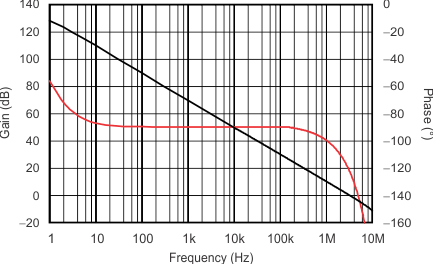
| RL = 10 kΩ and 10 pF, VS = ±2.5 V |
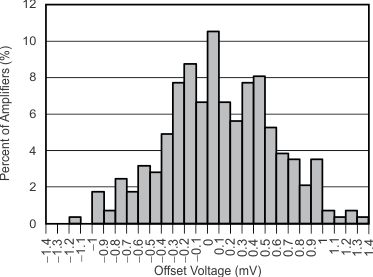
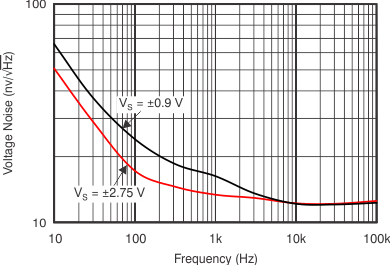
Frequency
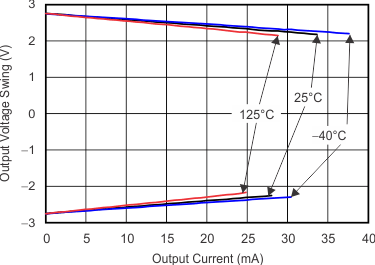
| VS = ±2.75 V |
(Over Temperature)
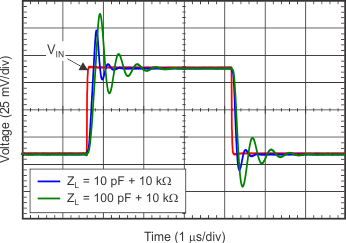
| VS = ±0.9 V, gain = 1 V/V, RF = 10 kΩ |
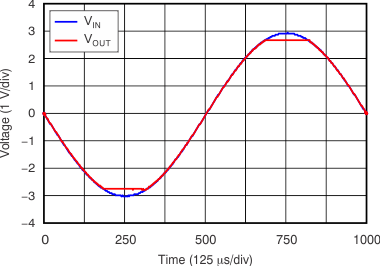
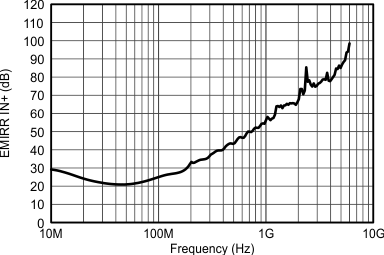
| PRF = –10 dBm, VS = ±2.5 V, VCM = 0 V |
Referred to Noninverting Input (EMIRR IN+) vs Frequency
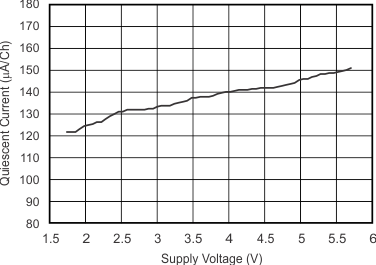
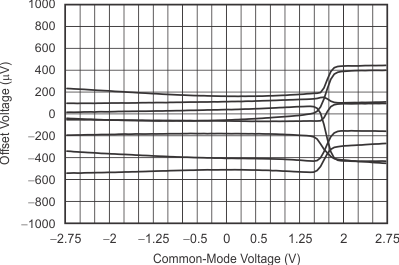
| Typical units, VS = ±2.75 V |
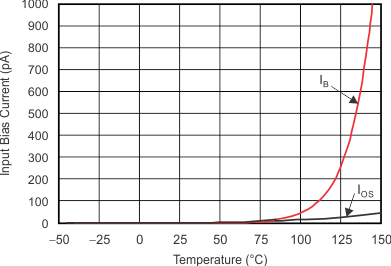
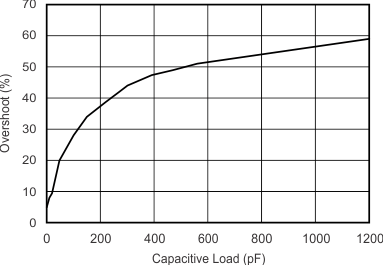
| VS = ±2.75 V, gain = 1 V/V, RL = 10 kΩ |
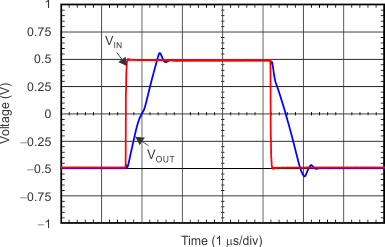
| VS = ±0.9 V, gain = 1 V/V, RL = 10 kΩ |
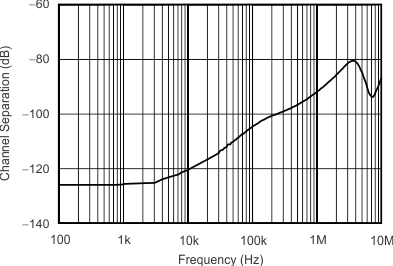
| VS = ±2.75 V |